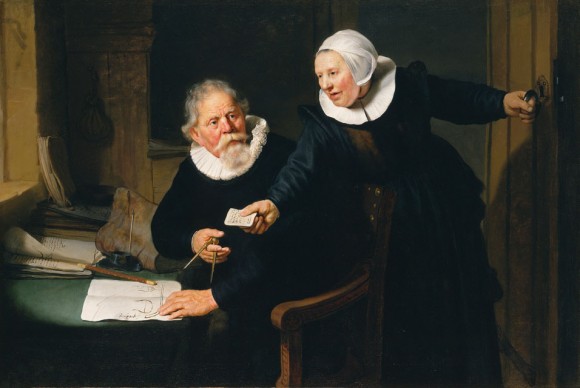Royal Collection Presents Exhibition of 42 Paintings of Dutch 17th-Century Landscapes
LONDON.- This exhibition of 42 paintings draws on the Royal Collection’s rich holdings of Dutch 17th-century landscapes, including works by Jacob van Ruisdael, Aelbert Cuyp, Jan van der Heyden and Meyndert Hobbema. By the 17th century, landscape painting was well established as a distinct art form and one in which Netherlandish artists excelled. The fine detail and meticulous finish of Dutch pictures appealed to British taste, and 34 of the works in the exhibition were acquired by the future George IV between 1809 and 1820. The ability of Dutch artists to depict mood and emotion through landscape and the subject-matter drawn from everyday life influenced the great British painters John Constable and JMW Turner. Constable admired the ‘acres of sky expressed’ in Ruisdael’s Evening Landscape: A Windmill by a Stream, and on seeing a seascape by Willem van de Velde the Younger, Turner remarked, ‘Ah! That made me a painter’. On view from April 15 through October 9, 2011.
At the conclusion of the Eighty Years War with Spain, the newly formed United Provinces of the north gained independence from the Spanish-controlled south. With a sense of national optimism came the rapid expansion of Dutch cities and towns. Civic pride manifested itself in the building of town halls and churches, and in paintings such as Jan van der Heyden’s minutely observed The Town of Veere with the Groote Kerk. A programme of land reclamation saw the northern peninsular of the United Provinces grow by a third between 1590 and 1650. Outdoor Merrymaking by Jan Miense Molenaer shows a typical Dutch ‘polder’ (reclaimed field) surrounded by a drainage ditch, dyke and windmills.
Between 1610 and 1630 a ‘tonal’ school of landscape painting emerged in Haarlem. It created a style that sought to convey through subtle transitions of colour the atmospheric effects of water, land and sky. In A River Landscape with Sailing Boats, Salomon van Ruysdael skilfully evokes the mood of dawn over the estuary through the blending of colour and texture. The thinly painted areas allow the grain of the wood to suggest ripples in the water.
The Royal Collection contains an outstanding group of works by Aelbert Cuyp, the most poetic of all Dutch landscape artists. Cuyp painted both recognisable views around Dordrecht and landscapes of his imagination, such as A Page with Two Horses. All are imbued with an extraordinary luminosity and spectrum of light. The earliest painting in the group, Cows in a Pasture beside a River, before Ruins, may have been intended as a celebration of the end of war and the anticipated benefits of peace.
As protectors of the land, sand dunes became a symbol of Dutch national pride. They are recurring motifs in landscape painting, either as the setting for seaside pastimes, as in Adriaen van de Velde’s Figures on the Coast at Scheveningen, or as the temporary home of hunters and soldiers, as in Paulus Potter’s Two Sportsmen outside an Inn. In A Hilly Landscape with a Hawking Party, Jan Wijnants exploits the decorative forms of twisting paths, broken fences and the rutted mud of the track. The artist may have been influenced by landscape decoration on contemporary Delftware or on Chinese porcelain imported by the Dutch East India Company.
As the foundation of trade and empire, the sea was the most important force in Dutch life. Ships were built in unprecedented quantities – around 40,000 vessels during the 17th century. The ‘Great Fishery’, as the herring trade was called, directly or indirectly employed one fifth of the population. The importance of the sea is reflected in the large number of marine artists active at this time. In The Royal Escape in a Breeze and A Calm: A States Yacht under sail Close to the Shore, Willem van de Velde the Younger skilfully depicts the changing effects of light and air, the direction of the sun and wind, and the behaviour of boats under different weather conditions.
While many Dutch painters found inspiration in their immediate surroundings, others, such as Karel du Jardin, Nicolaes Berchem and Cornelis van Poelenburgh, travelled to Italy in pursuit of the mountainous vistas and golden light. Since the early 16th century there had been a colony of northern artists in a small quarter of Rome immediately inside the Porta del Popolo. Figures before a Locanda by Johannes Lingelbach is set in the street where the artist lived and, rather than idealising the city, gives a realistic account of the squalor of low-life Rome. Karel du Jardin’s A Herdsman with an Ox, an Ass, and Sheep in the Campagna places its subject against the backdrop of the Roman countryside suffused with southern light, but the painting’s muted palette and careful observation remain typically Dutch. Aelbert Cuyp never ventured to the Mediterranean, but saw Italy through the works of his contemporaries. In his Evening Landscape with Figures and Sheep, the distinctly Dutch terrain is bathed in the warm colours and soft tones of Italy.
Related posts:
- Rijksmuseum Exhibits a Selection of Its Most Beautiful Drawings and Prints of Dune Landscapes
- Art Institute of Chicago Announces Major Acquisition of an Early 17th Century Painting
- Royal Couple Visits Double Infinity Exhibition at Dutch Culture Centre Shanghai
- 17th Century Automata Lion Clock Roars in £117,600 at Bonhams
- Paintings Not Seen for More than Half a Century Now on View at Alte Pinalothek

